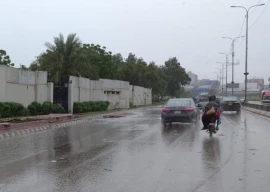
Considering that the entire land-surface of Pakistan is prone to regular — in fact increasingly regular — natural disasters, it is singularly poorly prepared. For five days, the Chitral valley, remote always and forever underserved, has been ravaged by floods. These are caused by glacial lakes bursting their boundaries, and rivers and streams in spate that have destroyed vital infrastructure. The Pakistan Army is at full stretch doing what it can to rescue people and the provincial government has offered the insultingly small sum of Rs1 million for “immediate assistance” — the fiscal equivalent of pocket-change. The monsoon rains are the ultimate cause of the calamity that is befalling Chitral, and there are around 200,000 people said to be cut off in the upper parts of the district.

It is too early to objectively assess the damage but even government officials are saying that “it could be a lot worse than it already appears to be”. Bridges have been hard hit with 240 — both large and small — washed out and nearly 400 houses destroyed or partially damaged. Food is reportedly in short supply as is potable water, and electricity supplies broken. Standing crops have been destroyed, livestock drowned. The valleys inhabited by the Kalash people have been utterly devastated. Disasters of this magnitude in such a remote place take years to recover from, perhaps a generation — and this is a disaster that was entirely predictable. Moreover, it is a disaster that can and in all probability will be repeated, if not next year then in succeeding years.
The picture elsewhere is not as serious but bad enough. Lower Kohistan has escaped major flooding but northern Balochistan has seen flooding and damage to roads and bridges. Water levels are rising in Punjab and there is a medium-level flood at the Taunsa Barrage caused by heavy rains in the Sulaiman Range. The Indus has flooded at Layyah causing a dyke breach and prompting the evacuation of a number of villages. All of the above damage — though fortunately a relatively low loss of life thus far — has been caused by rains that have been an annual event for countless millennia. The monsoon is not a surprise event happening out of the blue; it may vary in severity depending on the effects of global warming or El Nino but it always happens, and happens within a predictable time frame well-documented by meteorologists.
Natural severe weather events cannot be avoided, but their worst effects can be mitigated, and preparation made for post-event rescue and relief. Pakistan has three agencies which are tasked for disaster preparedness at the federal level, and provincial bodies below that. On paper there is a plenitude of preparedness, but this is not reflected in the ground realities where the three principal agencies — the National Disaster Management Authority (NDMA), the National Health Emergency Preparedness and Response Network (NHEPRN) and the Emergency Relief Cell (ERC) all have different masters. The NHEPRN works under the health ministry, the ERC is overseen by the Cabinet Division, whereas the NDMA reports to the prime minister.
Predictably the three do not coordinate, their areas of demarcation and responsibility/accountability are blurred and there is duplication of financial resources. In short, an object lesson in how not to manage disaster preparedness and a farrago more likely to add to distress and confusion rather than alleviate it. The very nature of disaster preparedness and relief demands that it is managed at an overarching level by a single body, and there is agreement among some of those working in the three agencies that their mandates overlap and they represent a poor use of scarce resources. Natural calamities are going to be a feature of life — and death — in Pakistan for as long as the state endures. At the very least, there needs to be a review of disaster preparedness mechanisms, preferably leading to the establishment of a single body responsible for disaster response. Sadly, it will come too late for the people of Chitral.
Published in The Express Tribune, July 22nd, 2015.
Like Opinion & Editorial on Facebook, follow @ETOpEd on Twitter to receive all updates on all our daily pieces.








































COMMENTS (1)
Comments are moderated and generally will be posted if they are on-topic and not abusive.
For more information, please see our Comments FAQ